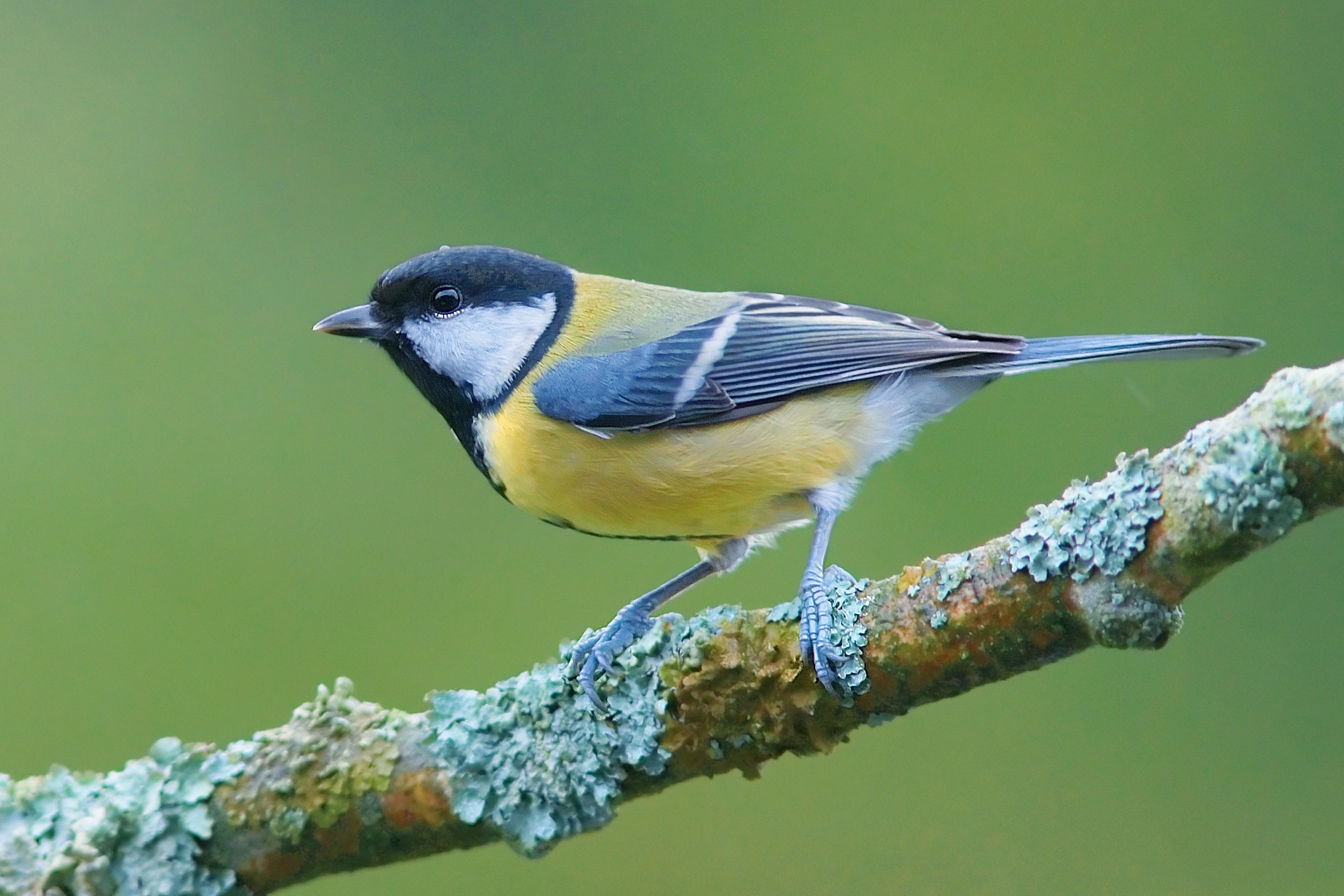- Great Tit
Taxobox
name = Great Tit
status = LC
status_system = iucn3.1
status_ref =IUCN2006|assessors=BirdLife International|year=2004|id=52108|title=Parus major|downloaded=5 May 2006 Database entry includes justification for why this species is of least concern]

image_width = 220px
image_caption = Male audio|Parus major.ogg|Birdsong
regnum =Animal ia
phylum = Chordata
classis = Aves
ordo = Passeriformes
familia = Paridae
genus = "Parus "
species = "P. major"
binomial = "Parus major"
binomial_authority = Linnaeus, 1758The Great Tit, "Parus major", is apasserine bird in the tit family Paridae. It is a widespread and common species throughoutEurope andAsia in any sort of woodland. It is resident, and most Great Tits do not migrate.Description
Great Tits are easy to recognize, large in size at 14 cm, with a broad black line (broader in the male) down its otherwise yellow front. The neck and head are black with white cheeks and ear coverts. Upper parts are olive. It has a white wingbar and outer tail feathers. In young birds the black is replaced by brown, and the white by yellow.
Great Tits come in many races, but they fall into three groups. Great Tits in temperate Europe and Asia are essentially green above and yellow below. Great Tits in
China ,Korea ,Japan and southeasternRussia are green above and white or yellow-tinged white below, and birds inIndia and south-eastAsia are grey above and whitish below.Voice
It is, like other tits, a vocal bird, and has a large variety of calls, of which the most familiar is a "teacher, teacher", also likened to a squeaky
wheelbarrow wheel. In the 1st Movement of Bruckner's 4th Symphony several Great Tit songs are strung together in a very realistic manner. Interestingly, Great Tits from the two south Asian groups of races do not recognize the calls of the temperate Great Tits, and they may be a separate species.Distribution and habitat
The Great Tit has a wide distribution across much of
Eurasia . It is found across all ofEurope except forIceland and northernScandanavia , and then across theMiddle East , NorthernMorocco andAlgeria and parts of centralAsia as far asJapan . Another band f distribution occurs through Iran into northern India intoSoutheastern Asia , whilst another population lives in southern India. The species also occurs over much ofChina ,Korea andJapan , and inIndonesia down intoBorneo and as far as theLesser Sundas .Behaviour
Great Tits will join winter tit flocks with other
species .Diet and feeding
Great Tits are primarily insectivores. They prefer protein rich caterpillars during breeding season to feed their young. [cite web|url=http://news.bbc.co.uk/2/hi/science/nature/7390109.stm|title=http://news.bbc.co.uk/2/hi/science/nature/7390109.stm Great tits cope well with global warming] A study published in 2007 found that Great Tits helped to reduce caterpillar damage in apple orchards by 50%. [Mols C & M Visser (2007) " [http://www.plosone.org/article/fetchArticle.action?articleURI=info:doi/10.1371/journal.pone.0000202 Great Tits ("Parus major") Reduce Caterpillar Damage in Commercial Apple Orchards"] . "PLoS ONE" 2(2): e202. doi|10.1371/journal.pone.0000202] In England, Great Tits learned to break the foil caps sealing bottles of milk that had been delivered to homes to obtain the cream floating on top. [Hawkins, T. (1950) " Opening of Milk Bottles By Birds" "Nature" 165 (4194): 435-436 doi|10.1038/165435a0]
Breeding
Great Tits are cavity nesters, breeding in a hole that is usually inside a tree, although occasionally in a wall, rock face, and they will readily take to
nest box es. The number in the clutch is often very large, but seven or eight white spotted red eggs are normal, with bigger clutches being laid by two or even more hens. The bird is a close sitter, hissing when disturbed.The nestlings are unusual for
altricial birds in having plumage coloured withcarotenoid s similarly to their parents. In most species it is dun-coloured to avoid predation. Thenape is yellow and attracts the attention of the parents by itsultraviolet reflectance. This may be to make them easier to find in low light or a signal offitness to win the parents' attention. This patch turns white after the firstmoult at an age of two months, and diminishes in size as the bird grows. [cite journal |author=Ismael Galván, Luisa Amo, and Juan J. Sanz |month=May |year=2008 |title=Ultraviolet-blue reflectance of some nestling plumage patches mediates parental favouritism in great tits Parus major |journal=J. Avian Biol. |volume=39 |issue=3 |pages=277–282 |doi=10.1111/j.0908-8857.2008.04273.x ]Relationship with humans
The Great Tit is a popular garden bird due to its acrobatic performances when feeding on nuts or seed. Its willingness to move into nest boxes has made it a valuable study subject in
ornithology , and it is one of the best studied birds in the world.References
*
* "Tits, Nuthatches and Treecreepers", Harrap and Quinn, ISBN 0-7136-3964-4Gallery
External links
* [http://www.rspb.org.uk/birds/guide/g/greattit/index.asp RSPB page]
* [http://www.bbc.co.uk/nature/programmes/radio/dawn_chorus/video/greattit_song.ram Song sample]
* [http://www.bbc.co.uk/nature/wildfacts/factfiles/249.shtml BBC fact file]
* [http://www.ibercajalav.net/img/394_GreatTitPmajor.pdf Ageing and sexing (PDF) by Javier Blasco-Zumeta] For more pictures of Tits:
* [http://ibc.hbw.com/ibc/phtml/especie.phtml?idEspecie=7418 Great Tit videos] on the Internet Bird Collection
* [http://imeleon.com/keywords/1/tit.html Great Tit photos]
Wikimedia Foundation. 2010.
